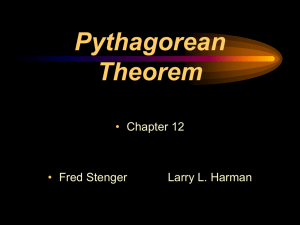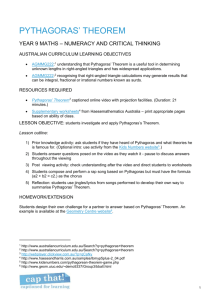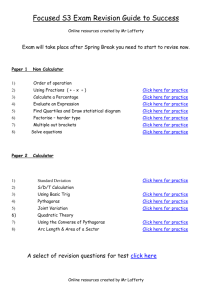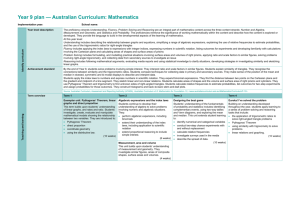PD_NVQ2_A_Ch7_7.7
advertisement
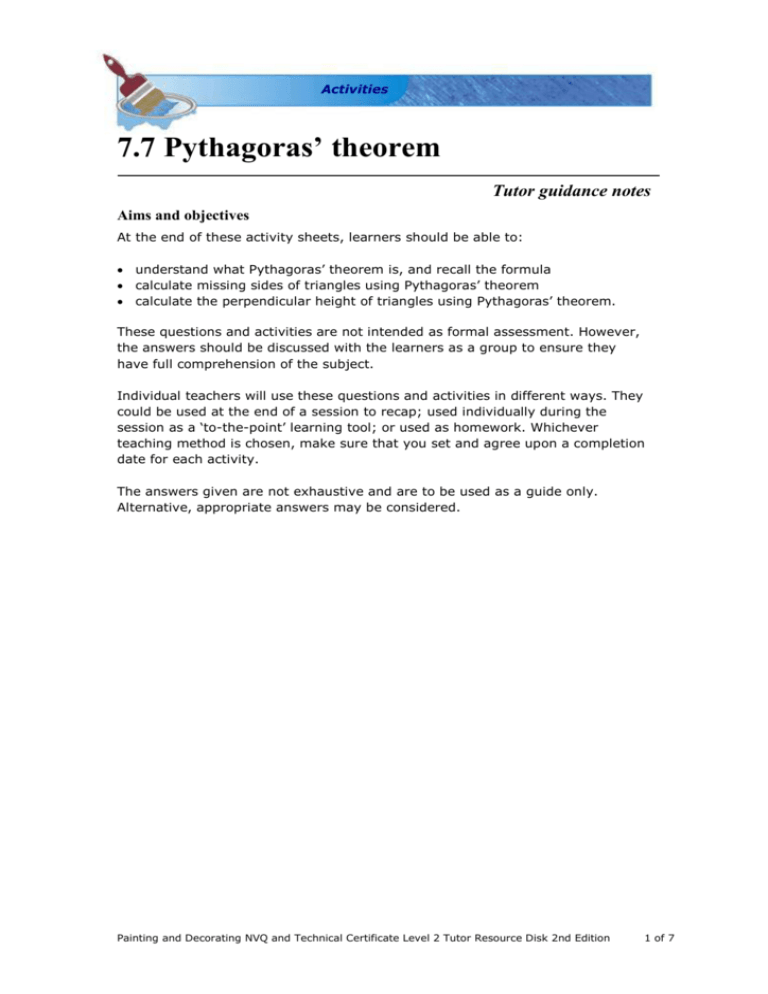
Activities 7.7 Pythagoras’ theorem Tutor guidance notes Aims and objectives At the end of these activity sheets, learners should be able to: understand what Pythagoras’ theorem is, and recall the formula calculate missing sides of triangles using Pythagoras’ theorem calculate the perpendicular height of triangles using Pythagoras’ theorem. These questions and activities are not intended as formal assessment. However, the answers should be discussed with the learners as a group to ensure they have full comprehension of the subject. Individual teachers will use these questions and activities in different ways. They could be used at the end of a session to recap; used individually during the session as a ‘to-the-point’ learning tool; or used as homework. Whichever teaching method is chosen, make sure that you set and agree upon a completion date for each activity. The answers given are not exhaustive and are to be used as a guide only. Alternative, appropriate answers may be considered. Painting and Decorating NVQ and Technical Certificate Level 2 Tutor Resource Disk 2nd Edition 1 of 7 Activities Candidate name: Date: 7.7 Pythagoras’ theorem Chapter 7: Numeracy skills Aims and objectives At the end of these activity sheets, you should be able to: understand what Pythagoras’ theorem is, and recall the formula calculate missing sides of triangles using Pythagoras’ theorem calculate the perpendicular height of triangles using Pythagoras’ theorem. Show your workings for all calculations. 1 What is Pythagoras’ theorem used for? ___________________________ ___________________________________________________________ 2 Which side of a triangle is called the hypotenuse? ___________________ 3 We name the hypotenuse c, and the other two sides of the triangle a and b. State Pythagoras’ theorem using these ___________________________ 4 Look at this list of square numbers and square roots. Are they all correct? Write ‘correct’ or ‘incorrect’ next to each one, and write the correct answers. 2² = 4 _____________________________________________ √64 = 6 _____________________________________________ 5² = 50 _____________________________________________ 4² = 20 _____________________________________________ √1 = 1 _____________________________________________ √49 = 7 _____________________________________________ 9² = 89 _____________________________________________ √36 = 6 _____________________________________________ 10² = 100 _____________________________________________ √9 = 4 _____________________________________________ Painting and Decorating NVQ and Technical Certificate Level 2 Tutor Resource Disk 2nd Edition 2 of 7 Activities 5 Calculate the missing lengths for these triangles. Give answers to one decimal place. a 9 cm a 6 cm b b 4 cm 11 cm c 12 cm c 7 cm Painting and Decorating NVQ and Technical Certificate Level 2 Tutor Resource Disk 2nd Edition 3 of 7 Activities 6 Use Pythagoras’s theorem to find the perpendicular heights, and then the areas, of these triangles. Round numbers to one decimal place where appropriate. a 5 cm h 2 cm 3 cm b 7 cm h 6 cm 2 cm c 4 cm h 4 cm 2.5 cm Painting and Decorating NVQ and Technical Certificate Level 2 Tutor Resource Disk 2nd Edition 4 of 7 Activities 7.7 Pythagoras’ theorem Chapter 7: Numeracy skills Answers 1 What is Pythagoras’ theorem used for? to find unknown lengths in right-angled triangles 2 Which side of a triangle is called the hypotenuse? the longest side 3 We name the hypotenuse c, and the other two sides of the triangle a and b. State Pythagoras’ theorem using these letters. c² = a² + b² 4 Look at this list of square numbers and square roots. Are they all correct? Write ‘correct’ or ‘incorrect’ next to each one, and write the correct answers. 2² = 4 √64 = 6 5² = 50 4² = 20 √1 = 1 √49 = 7 9² = 89 √36 = 6 10² = 100 √9 = 4 correct incorrect incorrect incorrect correct correct incorrect correct correct incorrect √64 = 8 5² = 25 4² = 16 9² = 81 √9 = 3 Painting and Decorating NVQ and Technical Certificate Level 2 Tutor Resource Disk 2nd Edition 5 of 7 Activities 5 Calculate the missing lengths for these triangles. Give answers to one decimal place. a a² = 9² – 6² = 81 – 36 = 45 a = √45 = 6.7 cm 9 cm a 6 cm b b 4 cm b² = 11² – 4² = 121 – 16 = 105 b = √105 = 10.2 cm 11 cm c 12 cm c 7 cm c² = 12² + 7² = 144 + 49 = 193 c = √193 = 13.9 cm Painting and Decorating NVQ and Technical Certificate Level 2 Tutor Resource Disk 2nd Edition 6 of 7 Activities 6 Use Pythagoras’s theorem to find the perpendicular heights, and then the areas, of these triangles. Round numbers to one decimal place where appropriate. a 5 cm h 2 cm h² = 5² – 3² = 25 – 9 = 16 h = √16 = 4 cm area = 1 2 × (2 + 3) × 4 = 1 2 ×5×4 = 10 cm² 3 cm b h² = 7² – 6² = 49 – 36 = 13 h = √13 = 3.6 cm 7 cm h 6 cm 2 cm area = 1 2 × (6 + 2) × 3.6 = 1 2 × 8 × 3.6 = 14.4 cm² c 4 cm h 4 cm 2.5 cm h² = 4² – 2.5² = 16 – 6.25 = 9.75 h = √9.75 = 3.1 cm area = 1 2 × (4 + 2.5) × 3.1 = 1 2 × 6.5 × 3.1 = 10.1 cm² Painting and Decorating NVQ and Technical Certificate Level 2 Tutor Resource Disk 2nd Edition 7 of 7


